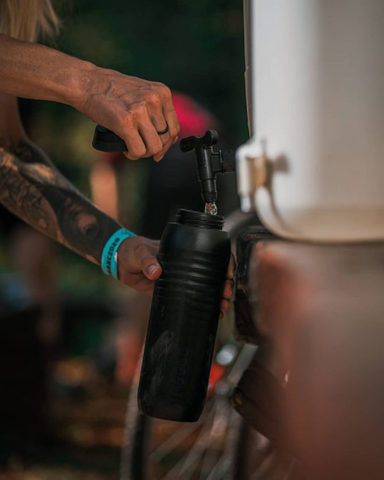Effects of plastic bottles on your body and the alternatives
BPA, BPS, BPF and other acronyms in my water
Let's start with the obvious: plastic residues in water can have a harmful effect on health.
Sounds logical and most people are aware of it. Ever since this information first hit the media, it has been impossible to imagine our supermarkets without the "BPA free" slogan.

Image by celebrate1 from Pixabay
BPA or "bisphenol A" is a plasticiser used in many plastic products. Plasticisers like BPA have been shown to have oestrogen-like effects in the body, throwing the sex hormones of both sexes out of balance. One result that has been linked to increased exposure to BPA is the declining sperm count in men over the years. A study published in 2017 speaks of a decrease of 52.4 percent between 1973 and 2011.(HumanReproductiveUpdate: Levine et al., 2017) An unnatural increase in estrogens is also not good for the female body. Several different types of cancer, such as breast cancer, are associated with hormone imbalance.
The result of this commercially disseminated knowledge is a decrease in the use of BPA. Other plasticisers and substitutes, such as BPS (bisphenol S), BPF (bisphenol F) or DEHP (diethylhexyl phthalate) are increasingly used as a result. As the name of the first two already suggests, BPS and BPF come from the same family as BPA and presumably have largely similar effects on the human organism.
Ok, it should be noted that plasticisers have no place in the body. But let's assume that a plastic bottle does not contain any plasticisers. What about the plastic itself?
Study after study found that so-called microplastics have become an integral part of our environment. We breathe plastic, eat plastic and unfortunately we drink it too. While certain foods, such as seafood, can be deliberately avoided to reduce plastic pollution, there is one elixir of life that cannot be dispensed with.

Image by congerdesign from Pixabay
Right! Water!
Daily water consumption is an essential part of a healthy diet and also vital for survival. An average fluid intake of 2l ensures the maintenance of vital bodily functions.
So where does the water we drink come from?
Since not all of us have our own spring behind the house, we often choose bottled water. And not too seldom, for various reasons, the water comes in plastic bottles. These are much lighter than glass bottles and, unfortunately, often the cheapest version of mineral water in the supermarket.
Apart from the fact that most "cheap" water bottles are quite obviously full of plasticisers, there is another, much more general problem with their use.
The plastic from which the bottles themselves are made.
According to this survey from the State University of New York:
- Tested 259 individual bottles from 27 different batches of 11 brands. Purchased at 19 locations in 9 countries.
- 93 % of the bottled water showed signs of microplastic contamination.
- With microplastic residues about 100 micrometres in size, roughly the diameter of a human hair, the bottled water samples contained more than twice as many microplastic pieces per litre (10.4) as the tap water samples (4.45).
Ok, we have understood that. So now we don't drink water from plastic bottles, but from glass bottles if we buy them. The direction is right, but the values from the study lead us to believe that a not harmless part of the plastic residues in the water are due to the lid. 54% of the polymers detected were polypropylene, a commonly used plastic for bottle lids. In glass bottles, the cap is usually also made of plastic, and the process of first unscrewing ("crack!") leads to small plastic particles getting into the water.

Image by Willfried Wende from Pixabay
Well... then just tap water. In many European countries, tap water is of drinking water quality and is often checked more critically than bottled water. True, true. But what do we fill the water from the tap into? Ideally, into a bottle that is easy to carry and there is no danger of it simply breaking when we put it down ungently. Sounds like a plastic bottle again, or am I mistaken?
As mentioned above, this is not the solution. A better bottle is needed!
At KEEGO, we have made it our mission to counteract the problem of "settling" between the practicality of a plastic bottle and the health benefits of using a metal bottle, and to somehow merge these two worlds. But how do you get a bottle that is light and squeezable like a typical plastic bottle and tasteless and unplasticised like a metal bottle? We decided on a core made of titanium and an outer layer of high-quality soft-touch material that protects the sensitive core and gives the bottle a pleasant feel.

Welcome to the world of KEEGO.
THE EVOLUTION OF THE DRINKING BOTTLE.
For all those who #keepgoing!
Sources:
Plastics and plasticisers:
- https://lostempireherbs.com/dangers-of-plastics/
- https://pubmed.ncbi.nlm.nih.gov/25376446/
- https://ehp.niehs.nih.gov/doi/10.1289/ehp.1408989
- https://orbmedia.org/stories/plus-plastic/
- http://news.bbc.co.uk/2/shared/bsp/hi/pdfs/14_03_13_finalbottled.pdf
Hormones and health effects:






